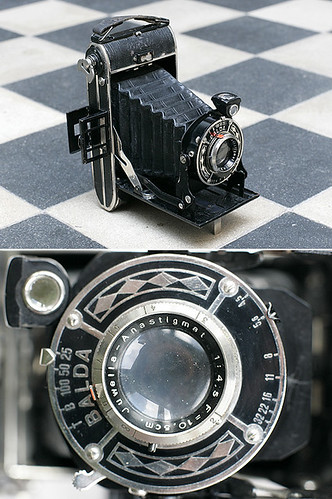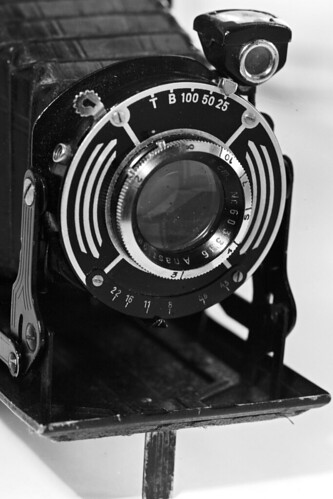Difference between revisions of "Balda Juwella"
m (Corrected wikilink to go to a section-heading, not top of page) |
Hanskerensky (talk | contribs) (Added link to review) |
||
| (One intermediate revision by the same user not shown) | |||
| Line 31: | Line 31: | ||
The camera has a ⅝-inch tripod bush. | The camera has a ⅝-inch tripod bush. | ||
| − | |||
| − | |||
| − | |||
==Notes== | ==Notes== | ||
<references/> | <references/> | ||
| + | ==Links== | ||
| + | *[http://www.artdecocameras.com/cameras/balda/jewella/ Balda Juwella review] at [http://www.artdecocameras.com/ Art Deco Cameras] | ||
| − | + | [[Category:Balda|Juwella]] | |
| − | [[Category: Balda]] | ||
[[Category: 120 film]] | [[Category: 120 film]] | ||
[[Category: German 6x9 viewfinder folding]] | [[Category: German 6x9 viewfinder folding]] | ||
[[Category: 1933]] | [[Category: 1933]] | ||
| − | [[Category: J|Juwella]] | + | [[Category:J|Juwella Balda]] |
Latest revision as of 04:38, 5 July 2023

|
| Juwella, 1936 or 1938 model image by Siim Vahur (Image rights) |

|
| Alternate shutter faceplate, also 1936 or 1938. image by Sten Oja (Image rights) |
The Juwella is a folding camera made by Balda in the 1930s. It makes 6×9 cm images (and some cameras can also be masked for 4.5x6 cm pictures; this was an optional feature) on 120 roll film. McKeown lists four generations of the camera, dated to 1933, 1936, 1938 and 1939.[1] The first of these was at first named the Jubella for a short period, to celebrate Balda's 25th year (as the Jubilette was named for the company's 30th year in 1938); Jubellas are identified by the name impressed in the leatherette, and the lens has the same name.[1]
The camera is self-erecting, with a button to release the front next to the film winding knob or key.
The lens is a fixed 10.5 cm f/6.3 or f/4.5 Juwella Anastigmat (or Jubella in the earliest cameras), with front-element focusing to about two metres. Many examples have an everset shutter with speeds 1/25 - 1/100 second, plus 'B' and 'T'; this may be Balda's own, or a Pronto, with the same speeds but also with a self-timer. McKeown states that better-specified shutters including Compur and Prontor II were available on at least the 1938 camera. A body-mounted shutter release button was an optional feature of the 1939 model,[1]; however, some cameras from 1936 onwards have a curious clasp mounted on the front, just above the front door, which holds the end of a cable release (thus providing a body-mounted shutter release).
In most examples, the main viewfinder is a double frame type, with extra frames for the half-frame format on those cameras adapted for it. McKeown states that a reverse-Galilean finder was an option from 1938.[1] There is also a Brilliant finder mounted on the lens standard, which swivels for horizontal and vertical use.
The earliest Juwellas have a film winding knob, which is replaced with a winding key in later models. the film compartment opens with a small sliding latch (marked with an arrow) by the carrying strap. In the back, there is a swing-out holder for the full spool; at the other end, the winding key must be pulled out to fit the take-up spool.
The camera has a ⅝-inch tripod bush.
Notes
- ↑ 1.0 1.1 1.2 1.3 McKeown, James M. and Joan C. McKeown's Price Guide to Antique and Classic Cameras, 12th Edition, 2005-2006. USA, Centennial Photo Service, 2004. ISBN 0-931838-40-1 (hardcover). ISBN 0-931838-41-X (softcover). p104-5.